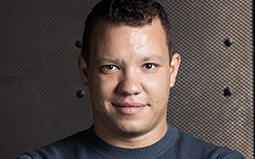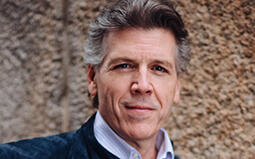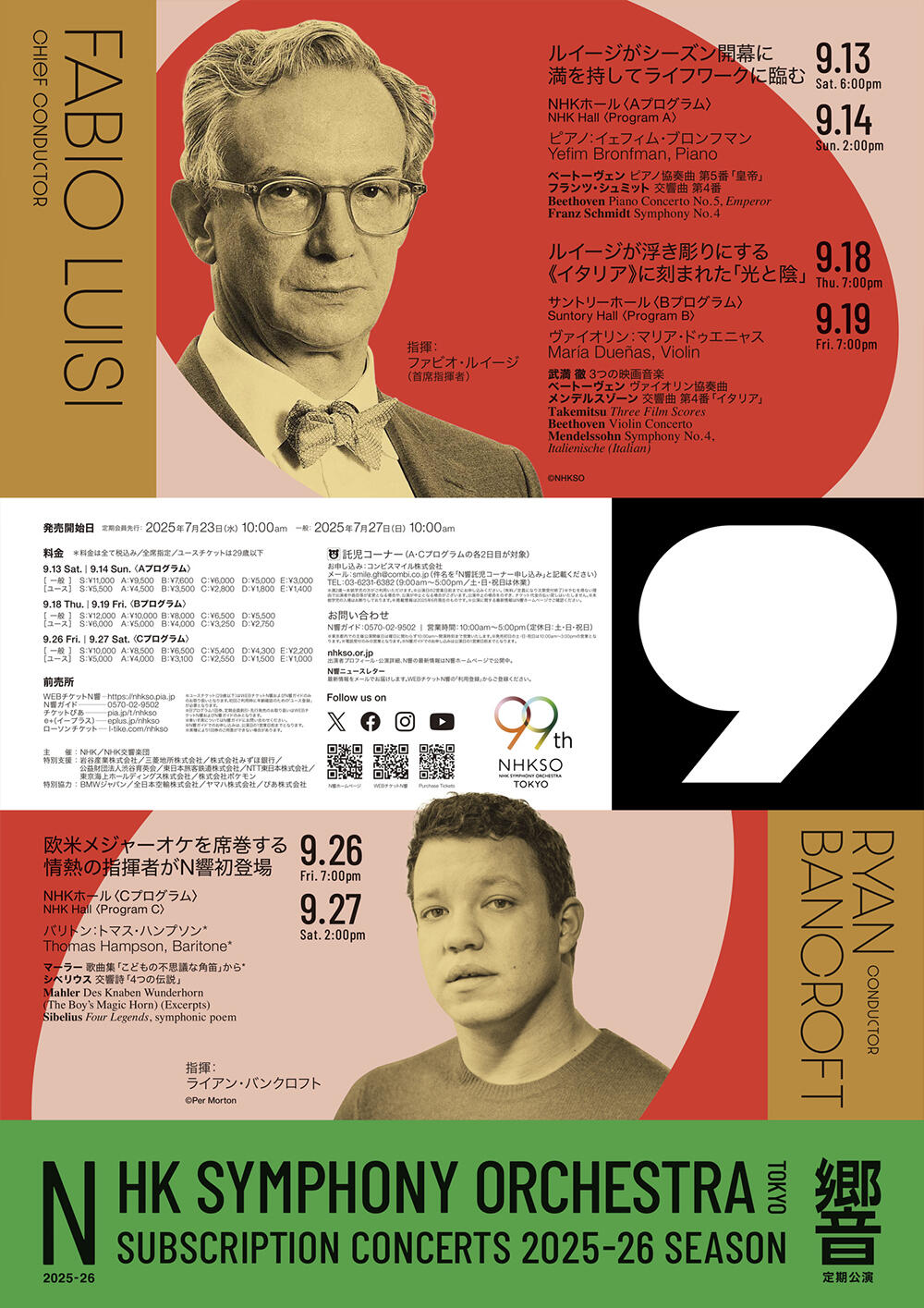- Home
- Concerts
- Subscription Concerts
- Program C
- No. 2044 Subscription (Program C)
No. 2044 Subscription (Program C)

Program
Mahler / Des Knaben Wunderhorn (The Boy’s Magic Horn) - Rheinlegendchen (Little Rhine Legend)*, Wo die schönen Trompeten blasen (Where the Fair Trumpets Sound)*, Das irdische Leben (Earthly Life)*, Das himmlische Leben (Heavenly Life)*, Urlicht (Primeval Light)*
Born in Bohemia, then in the Austrian Empire, Gustav Mahler (1860–1911) was a leading opera conductor during his lifetime, assuming particularly the directorship of the Vienna Court Opera (today the Vienna State Opera). Deeply read in literature as well, he left us some important song cycles with orchestral accompaniment and symphonies requiring voices as represented by No. 8 Symphonie der Tausend (Symphony of a Thousand) (1907) and Das Lied von der Erde (The Song of the Earth) (1909).
In the case of his symphonies No. 2 (1894), No. 3 (1896) and No. 4 (1900), they are collectively known as the Wunderhorn (Magic Horn) Symphonies, for they are inextricably bound up with Mahler’s own song series Des Knaben Wunderhorn (The Boy’s Magic Horn) for voice and orchestra. The songs were composed based on German folk poems from a collection of the same title edited by Achim von Arnim and Clemens Brentano. Our baritone Thomas Hampson, a leading figure in Mahler’s vocal music, will perform five songs from the series for us.
Rheinlegendchen (Little Rhine Legend) is a monologue of a woman about tossing her ring into the Rhine to get her lover’s attention.
Wo die schönen Trompeten blasen (Where the Fair Trumpets Sound), resounding with trumpet retreat command, is a dialogue between a woman and the spectre of her lover, a soldier killed in battle.
Das irdische Leben (Earthly Life) is a child’s repetitive imploration for food, who ends up dying of starvation. The melody is quoted in the Purgatory movement of Mahler’s Symphony No. 10.
Das himmlische Leben (Heavenly Life) is about the joy of heaven (“We wallow in heavenly pleasures” ... “Delicious apples, delicious pears and delicious grapes!”). Mahler will remake this song as the finale for soprano and orchestra in his Symphony No. 4. The chorale-like melody of these twin pieces is also heard in the What the Angels Tell Me movement (IV) of his Symphony No. 3.
Urlicht (Primeval Light) is a profound prayer (“Man lies in greatest pain, I would rather be in heaven” ... “Dear God will give me a light, To light my way to the eternal blessed life”). This song forms the fourth movement for alto and orchestra of Mahler’s Resurrection Symphony No. 2.
[Kumiko Nishi]
Sibelius / Four Legends, symphonic poem Op. 22
The timeless pride of Finland, Jean Sibelius (1865–1957)—five-year junior to Mahler—left his double mark on music history, as an important symphonist following the pan-European tradition and as the establisher of the Finnish national identity in music. An early successful example of the latter is Four Legends from the Kalevala (also known as Lemminkäinen Suite after the eponymous hero), a set of four symphonic poems premiered in 1896 (the composer will make revisions to them later). The Kalevala is Finland’s mythological epic which led a national awakening through the second half of the nineteenth century and thus paved the way for the country’s independence from Russian rule in 1917.
I Lemminkäinen and the Maidens of Saari establishes the home key of the suite (E-flat major). Opened by a dreamy horn call, the music eventually peaks at a jauntily merry moment of maidens dancing. The handsome lady-killer Lemminkäinen is on an island to seduce and win the heart of all the maidens but Kyllikki, the belle of the island. He abducts her and persuades her to be his wife.
II The Swan of Tuonela is the most popular of the cycle. Tuonela is, according to the first edition of the score, “Hades surrounded by a large river of black water” on which “the swan of Tuonela glides majestically and sings.” Sibelius entrusted the role of this singing swan to the English horn: indeed, its pear-shaped bell, its long main body and its bocal (curved thin tube that the reed is attached to) remind us of a swan, whilst its plaintive tone fits the piece’s mysterious, mournful setting well. Depicting the scene with a vivid imagination, the composer, an eminent violinist as well, displays great ability as an ingenious orchestrator: especially, his meticulous treatment of the strings—divided into thirteen parts at the beginning—produces a remarkable effect throughout the piece.
III Lemminkäinen in Tuonela full of swift eerie tremolos (tremulous effect) on strings, is exceptionally dramatic. Here our hero heads down to the Hades of Finnish mythology in order to shoot the sacred swan with a poisoned arrow. This is a trial set by the wicked queen of the Pohjola for him to take her daughter for his new wife. However, on the shore his enemy, a blind herdsman, kills Lemminkäinen whose body is pushed into the river and dismembered. Informed of his death, his mother arrives at Tuonela to gather his body parts and then a magical power brings him to life.
Headed “con fuoco”(fierily), IV The Return of Lemminkäinen starts in C minor. It is a galloping piece in perpetual motion which depicts the hero on his way back home following his mother’s persuasion. Towards the end, the piece returns to the cycle’s “home” key, E-flat major, to conclude in a triumphant manner.
[Kumiko Nishi]
[Encore]
Mahler / Das Knaben Wunderhorn (The Boy's Magic Horn) ― Wer hat dies Liedel erdacht? (Who Made Up This Little Song?)
Thomas Hampson, Baritone
Ryan Bancroft, Conductor
NHK Symphony Orchestra, Tokyo
Artists
 ConductorRyan Bancroft
ConductorRyan Bancroft
Born in 1989 in California, USA, Ryan Bancroft is one of the up-and-coming conductors gaining the greatest attention. Currently, he serves as the Chief Conductor of Sweden’s Royal Stockholm Philharmonic Orchestra (2023–), the Principal Conductor of the UK’s BBC National Orchestra of
Wales (2021–), and the Artist in Association of Finland’s Tapiola Sinfonietta (2021–). After opening his tenure as Chief Conductor in Stockholm in 2023, Bancroft’s second season 2024/25 with his orchestra includes performances of Mahler and Bruckner symphonies alongside world premieres of new pieces, whilst working with renowned soloists such as Leif Ove Andsnes, Maxim Vengerov and Víkingur Ólafsson.
He studied trumpet at the California Institute of the Arts, before going on to receive a Master of Music in orchestral conducting from the Royal Conservatoire of Scotland. While studying, he played trumpet with the BBC Scottish Symphony Orchestra on many occasions. He continued his conducting studies in the Netherlands and is a graduate of the prestigious Nationale Master Orkestdirectie run jointly by the Conservatorium van Amsterdam and the Royal Conservatoire The Hague.
Since his success at the prestigious Malko Competition for Young Conductors in 2018, where he won the First Prize, he has established himself as a regular guest conductor with leading orchestras including the Boston Symphony Orchestra (at the Tanglewood Festival), Los Angeles Philharmonic, Cleveland Orchestra, Philharmonia Orchestra, London Philharmonic Orchestra, BBC Symphony Orchestra, Deutsches Symphonie-Orchester Berlin, City of Birmingham Symphony Orchestra and the Ensemble intercontemporain.
For his NHK Symphony Orchestra debut, the chief of the two leading Nordic orchestras will conduct the Finnish composer Sibelius’s symphonic poem Four Legends, whilst collaborating with the world-renowned baritone Thomas Hampson, his compatriot, in Mahler’s Des Knaben Wunderhorn (The Boy’s Magic Horn) songs.
 Baritone*Thomas Hampson
Baritone*Thomas Hampson
American baritone Thomas Hampson, born in 1955, has long been recognized as one of the most innovative and multifaceted musicians of our time.
With more than eighty operatic roles in his repertoire, he shines across a vast array of styles, languages and periods. From Rossini’s elegance to the dramatic depths of Verdi and the modern innovations of contemporary masterpieces, he has portrayed characters that span the full spectrum of human experience and emotion.
A celebrated “ambassador of song,” he is a tireless advocate for the art of the recital, where his ability to connect with audiences through the intimacy of song has made him a beloved figure on stages worldwide. His programs often highlight the rich tradition of German Lieder, particularly the works of Mahler, Schubert, Brahms and Schumann, as well as American song, a genre he has championed with unparalleled dedication.
This is his first appearance with the NHK Symphony Orchestra in a long interval since November 1999 when he shared the stage with the veteran Wolfgang Sawallisch conducting the orchestra on the 50th anniversary of Richard Strauss’s death. This time, he will sing under American rising conductor Ryan Bancroft in Mahler’s Des Knaben Wunderhorn (The Boy’s Magic Horn) songs.
Download
Ticket
Single Tickets Release Date
Pre-sales for Subscribers:Wednesday, July 23, 2025 10:00am
*about subscribers
Sale to General Public:Sunday, July 27, 2025 10:00am
Price
| S | A | B | C | D | E | |
|---|---|---|---|---|---|---|
| Ordinary Ticket | 10,000 | 8,500 | 6,500 | 5,400 | 4,300 | 2,200 |
| Youth Ticket | 5,000 | 4,000 | 3,100 | 2,550 | 1,500 | 1,000 |
*tax included
*Subscribers receive a 10% discount (Available at NHKSO WEB Ticket and N-Kyo Guide)
*For wheelchair-accessible seats, please refer to the N-Kyo Guide
*Please note that single tickets may not be available depending on ticket price range
Youth Tickets
Youth Tickets are great options for those of 29 years old and younger
Subscription tickets
Release Date
ANNUAL SUBSCRIPTION TICKETS/
SEASONAL SUBSCRIPTION TICKETS (AUTUMN)
Sun., July 13, 2025 10:00am
[For Subscribers: Sun., July 6, 2025 10:00am]
Where to buy
NHKSO WEB Ticket | Fri., September 26 (In English / Seats not selectable on the English site)
NHKSO WEB Ticket | Sat., September 27 (In English / Seats not selectable on the English site)
NHKSO WEB Ticket (In Japanese / Seats selectable)
N-Kyo Guide (Purchase by telephone only)
Other Ticket Agents
Broadcast
 NHK Educational TVClassical Concert Hall
NHK Educational TVClassical Concert Hall
No. 2044 Subscription (Program C)
Sunday, Oct 19, 2025 9:00PM - 11:00PM
Program:
Mahler / Des Knaben Wunderhorn (The Boy’s Magic Horn) - Rheinlegendchen (Little Rhine Legend)*, Wo die schönen Trompeten blasen (Where the Fair Trumpets Sound)*, Das irdische Leben (Earthly Life)*, Das himmlische Leben (Heavenly Life)*, Urlicht (Primeval Light)*
Sibelius / Four Legends, symphonic poem Op. 22
Conductor:Ryan Bancroft
Baritone*:Thomas Hampson
Recorded:September 26, 2025 NHK Hall
To watch a concert,
(accessible only from inside Japan)
(accessible only from inside Japan)
Organized by: NHK (Japan Broadcasting Corporation) / NHK Symphony Orchestra, Tokyo
*Repertoire, conductor, soloists and program order are subject to change without notice.
*Pre-school children are not allowed in the concert hall.



